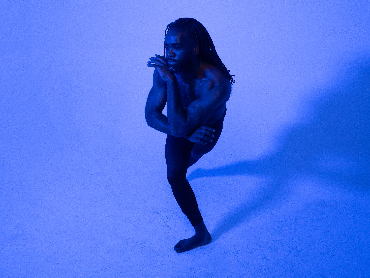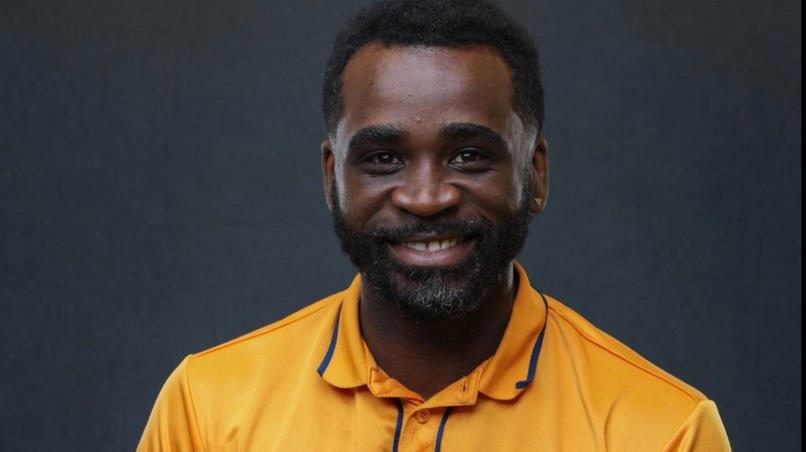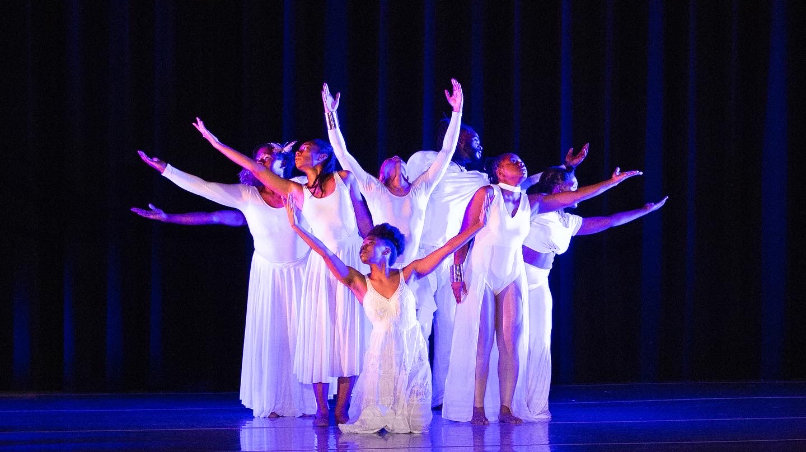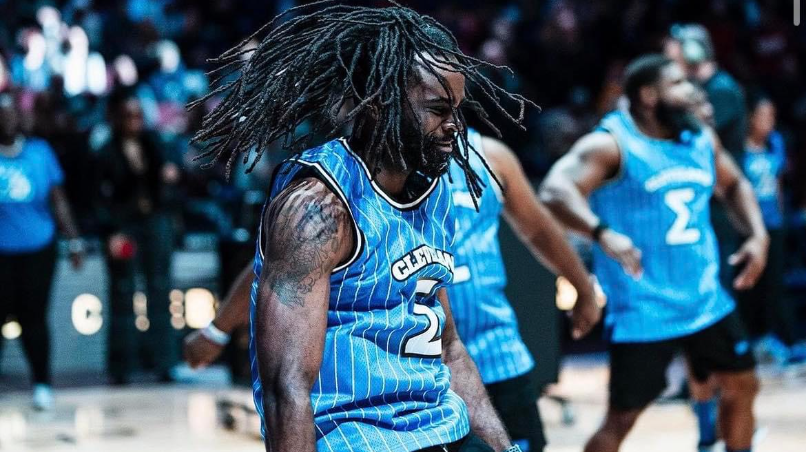
Photo Credit: RonDale Simpson
by Jason Eugene
Cleveland, Ohio—a city RonDale Simpson, founder and artistic director of Blakk Jakk Dance Collective, calls “the miracle by the bay.” It wasn’t on his “Bingo card” when he envisioned his life and career. He arrived in 2015, intending to visit a friend from Central State University for a week. He ended up staying, drawn into a city virtually unknown to him. What was suppose to be a simple visit turned into a few months, starting off as an invite by his friend and turning into a relationship ruined by miscommunication, intrigue and “petty games“. Yet, after spending some time in town, he discovered a rich history and traditions, offering ample opportunity to grow and establish himself and his dance collective. But RonDale’s journey to finding a home and building a thriving dance collective is became something much larger- it became a testament to navigating a life of turbulence, reclaiming his identity, and finding self empowerment against the backdrop of a society ingrained with biases, bigotry, and challenges.
His story begins not in Cleveland, but Saginaw, Michigan. A childhood marked by volatility, pain, and separation. His mother battled drug addiction, leading to the breakup of their family unit. RonDale and his three siblings were split up as children, sent to live in different households, and eventually put into the foster system. He recalls being the last to find a placement after his siblings, spending some time in a juvenile center where he felt all alone. When he was finally placed into a home, one that one might assumed would be ideal considering the gravity of his situation, it was anything but a safe and happy place; and the irony to it, it was his aunt’s home… his mother’s sister. The situation was far from stable. His aunt ran with “the North Side Gang”, bringing a certain energy that, even as a child, RonDale sensed he was in bad company. Making matters worse, she already had children of her own, which create for a challenging setup.
This early life was steeped in harsh realities. RonDale witnessed domestic abuse involving his mother and aunt with their partners. More profoundly, he experienced molestation as a child, an experience he had not shared before with too many others. He remembers later understanding the wrongness of it, that it wasn’t his fault or blame regardless of circumstances. But the trauma took a its toll, nonetheless.
Children in foster care or separated from their biological families due to parental substance abuse face disproportionately high rates of trauma and adverse childhood experiences. According to data from the U.S. Department of Health and Human Services, parental substance abuse is a leading reason for a child’s removal, affecting hundreds of thousands of children annually. These children are at increased risk for mental health issues, developmental delays, and struggle in school or to find their place in the world. RonDale’s experience aligns with the profound and lasting impact of such instability and trauma.
Coupled with family turmoil was the external pressure of identity and self-love. Growing up African American, a Black male, he faced teasing and ridicule for being dark-skinned, queer acting, having speech issues, and many other unimaginable torments. He notes that, he discovered at a young age that society favors lighter skin, believing “Lighter was brighter, lighter was better. The lighter skin you wore, the prettier, the more accessible you were“. Finding joy, love, and appreciation for his own skin tone was a journey- a pilgrimed. He also grappled with his burgeoning sexuality in an environment where religious views and traditional expectations for Black boys and men clashed with his innate being. “Why would I be made this way?” he recalls thinking to himself. “And religion told me I can’t be this way,” he reflects. There was a struggle to find balance between what was perceived as masculine (playing sports) and what he loved (dancing). He felt a pressure to mold into a certain way, to fit boxes others expected him to occupy, all without regard for his spirit… his person. “I hated the way that I was,” he admits, “why am I the way that I am? And how can I change that?“

Photo Credit: Blackk Jackk Dance Collective
This internal conflict and the external pressures of his environment shaped him into a “chameleon”. He learned to blend into every environment to avoid being a problem, not wanting to be sent back to a depressive detention center and not having a home, seeking to be “unbothered and liked and accept it“. This mask, while providing a form of safety, also led him to keep things private and avoid dealing with his own issues, focusing instead on making others happy. “Long as everyone’s happy, I’m happy,” was his mantra for a long time. This people-pleasing tendency reached a point where he would hurt himself to ensure others were “great”.
Amidst this challenging landscape, dance emerged as a sanctuary and a voice. Even as a child, he was “one of those kids that always could dance“, picking things up fast. Michael Jackson was his biggest inspiration, and he enjoyed portraying him in school events. Marching band and the army became his “ticket out”, providing years of movement, exposure to different cultures, people from around the world, and music styles, and even the opportunity to be a drum major. This early dance and performance experience, though not formal training in a studio sense, was his foundation.
“Dance got me there… Dance got me through the military. Dance got me through college. Dance got me all over the world”.
Navigating military service as an openly LGBTQ+ individual has been a complex and often challenging experience in American society. Policies have evolved dramatically, from outright bans to “Don’t Ask, Don’t Tell” (DADT), and eventually, the repeal of DADT allowing openly gay individuals to serve. More recently, the military has navigated policies regarding transgender service members, which continues to be a hot button topic. Despite policy changes, LGBTQ+ service members have historically faced discrimination, harassment, and barriers to advancement. Data from organizations like the Palm Center and the Williams Institute at UCLA School of Law have documented these challenges, highlighting higher rates of stress and discrimination reported by LGBTQ+ military personnel compared to their heterosexual counterparts. For Black LGBTQ+ individuals, these challenges can be compounded by racial discrimination. Which, mind you, in my opinion, is an incredibly odd and paradoxical thing given the person next to you in the heat of battle, queer and all, is someone which you may rely upon to save your life.
RonDale’s journey reflects a search for belonging and validation, a theme resonant with many navigating marginalized identities. The struggle to reconcile faith, identity, and societal expectations is a common thread for Black LGBTQ+ individuals. For example, writer and activist James Baldwin, another queer man, often explored the complexities of race, sexuality, and religion in his work, writing about the tension between the church’s teachings and his identity. Baldwin once wrote, “You have to go the way your blood beats. If you don’t live the only life you have, you won’t live some other life, you won’t live any life at all.” A powerful and telling observation, and profound guidance for those needing (and willing) to hear it. Later figures, like activist and writer Janet Mock, have spoken extensively about the journey of self-acceptance and finding power in owning one’s truth despite societal pressures. RonDale’s path to finding his voice and accepting himself, particularly his sexuality in college, echoes these larger narratives of overcoming shame and seeking internal validation.
After his brief, challenging return to Saginaw in 2015, RonDale took the Greyhound to Cleveland to visit a friend. It was that visit which turned into a permanent move, the one that transitioned from something that was supposed to be positive and turned nightmarish, became one of his biggest life lessons- “find your group and those whom you can trust“. He lost his job, phone, and wallet, his new Cleveland home, leading to a physical collapse from fatigue and dehydration. He documented his mental breakdown live on social media, only to be rescued by another friend who took him in and helped him get back on his feet. A pivotal moment occurred in the hospital when a Black physician spoke to him with unexpected care and directness: “You can’t keep doing this, man… You got too much going on for you. It’s sad to see another black man end up in a situation like this… When you get out of here, get your life right. I don’t want to see you back here“, hinting to the he had been in this position before. However, and luckily, the physician’s words struck RonDale deeply. He recalls having his public mental breakdown on Facebook Live shortly and expressing his exhaustion and desire to start over, so the timing of it all was somewhat divine you might say. This vulnerability led to support from someone who saw his struggle and offered help, marking the beginning of his emergence from a dark place into the man he is today.

Photo Credit: Blackk Jackk Dance Collective
tarting over in Cleveland, a place where he had no family here, no connections and no connection to at all, required building from scratch. And that’s what he set out to do. He used his experiences and his marketing degree, which he describes as “weaponizing” for personal interaction. He found a network, noting Cleveland is a “pocket place” where relationships and networking are key. He also began seeking formal dance training as an adult, joining the Rainey Institute. Here, he encountered mentors like Darnell Weaver, Michael Metcalf, Baba Stanford Barry, Gregory King, and Diane McIntyre, whom he describes as legends. Taking ballet alongside younger students, he finally received the foundational training he had lacked. This experience helped him realize that the talent and understanding he sought externally had been within him all the while. “Everything that I needed was already on the inside,” he finally understood.
A crucial turning point arrived in 2018. After graduating from Central State, he auditioned for Step Africa in Washington D.C., a company dedicated to stepping and other African dance forms. It was a company he had admired since 2009. Traveling alone, he made it through cuts but was initially told he didn’t make the callback. Then, a call brought him back for the final round. Though he ultimately didn’t make the company, the experience was life-changing, providing him with the validation he need to keep pushing forward. Being seen by world renowned artists affirmed that his talent and performance level were “valid”. From that moment, he knew his purpose: to return to Cleveland and create the training space and feeling he experienced for the youth there. The impetus for founding Blakk Jakk Dance Collective arrived unexpectedly during the COVID-19 pandemic. Originally, RonDale envisioned pursuing an independent dance career, traveling, and working with artists. He had just completed a choreographer’s cohort led by Errin Berry-Weaver of Mojuba Dance Collective, which equipped him with skills in creating, expressing, and marketing dance. The pandemic shut down his plans, leaving him with “a bunch of content, a bunch of choreography, a bunch of ideas,” but “no bodies, no equipment, no resources, no video“.
As the world began to cautiously reopen, RonDale reached out to friends to simply dance together safely in the park. This casual gathering sparked something more interesting than expected. The context of the pandemic, the riots in Cleveland and globally, and the heightened awareness of injustices against Black people, including the murder of George Floyd, created an overwhelming emotional landscape. RonDale felt he had so much to say but struggled to process it. Dance provided the outlet.
“Blackjack at the time gave me the space and the voice to be able to say what I needed to say,” he explains, allowing him to express himself without coming off as “irate, angry, or… having to hurt harm or hurt myself or put myself in a position where I could be a target“. Dance gave him a sense of purpose, a voice, and “time to just breathe and digest everything that was happening“. His piece “Through My Lens” emerged from this period, exploring his navigation of the world as a Black man and artist.
Launching the collective during the pandemic was pretty bold, given the uncertainty and the need for social distancing. He was aware of the boundaries but felt compelled to act, to “make the most of what I have“. He prioritized safety with masks and distancing. His focus became a holistic approach to the dancers, addressing their mental well-being and using movement for healing.
The name “Blackjack Dance Collective” holds significant personal meaning, transforming past pain into power. Originally intended as his artist persona name, he chose “Blackjack” to repower the teasing he endured as a kid for being dark-skinned. “Black” was a word heavily used against him, and “Jack” is his middle name. He changed the spelling to “Jakk,” referencing an organization he wanted to join (2K) and subtly nodding to the KKK (3K) with his preferred 4Ks (Black + Jakk = 2+2=4). It represents giving power back to his culture and community, declaring that “black is beautiful, black is amazing, black is excellence, black is everything“. The collective got its name officially at a drive-in performance when an audience member asked where they could find the group. RonDale spontaneously offered his personal name, transforming it into the collective’s identity.
Blakk Jakk Dance Collective distinguishes itself by showcasing “all black dancers” performing a diverse range of styles beyond just hip hop. Their repertoire includes contemporary, African dance with a jazz flare, stepping rooted in the HBCU tradition, ballet, Horton, and Dunham techniques. RonDale notes this diversity is often a “surprise and a shocker” to audiences. The collective intentionally features dancers with “different styles of bodies and shades of black represented“. This visual representation is powerful, making people feel more comfortable and allowing them to “see themselves doing it too”. Some individuals have even joined the company after seeing a performance and seeing themselves reflected on stage. The themes explored by the collective are deeply resonant with Black identity and experience. They focus on “black representation”. Sankofa, the Akan concept of looking back to the past to inform the future, is a “huge” theme. Storytelling is central, giving “unsung voices that opportunity to speak” and telling “untold or… not common stories that can get lost sometimes“. They explore the balance and intertwining of masculinity and femininity and highlight the importance of LGBT stories. The work is guided by “everyday life” and the environment.

Photo Credit: RonDale Simpson
“You can’t keep doing this, man… You got too much going on for you. It’s sad to see another black man end up in a situation like this… When you get out of here, get your life right. I don’t want to see you back here”
RonDale’s dedication extends to arts education. He works as a Master Teaching Artist with the Center for Arts-Inspired Learning, developing and leading programs for various age groups. He teaches at three different schools weekly. His teaching experience, working with a diverse range of students from 11/12 year olds to adults, directly influences his approach with Blakk Jakk, which includes members ranging from around 11/12 to 44. He brings experiences and lessons learned from teaching back to the collective and shares the collective’s work with his students. This exchange reinforces his mission of using dance to help individuals process emotions and challenges. When discussing topics like police brutality, he finds that students who have been affected “see themselves in me,” which helps them “loosen up and kind of exist in a moment“.
On a personal level, RonDale’s passion for dance and community is driven by the opportunity to externalize his internal world, turning “the things in my head” into reality and honoring ideas he’s wanted to create. Seeing his choreography and movement realized on other bodies is “gratifying,” and he finds joy in seeing his dancers take his work and recreate from it, personally motivating others.
He also connects his dance practice to a spiritual experience, drawing from his upbringing in the church. He meditates through dance, which has led him to explore holistic practices like aligning chakras, using stones, and listening to specific tones or frequencies. These practices provide internal peace and help him “open up the spaces and unlock things that I suppressed through movement“. He incorporates yoga stretches and breathing into his dance art. These practices are integral to his well-being and healing journey, helping him navigate the lasting impacts of childhood trauma and addiction. He speaks openly about his struggle with alcohol addiction in college, realizing it was a problem despite not fitting his prior definition of addiction, “Long as I don’t do drugs or street drugs, I won’t be considered an addict“. He recognized the detrimental effects on his health and mental state. Coming to terms with this required acknowledging the problem and seeking control, a process he is thankful to be in a better place with now. This self-awareness and commitment to healing are part of his ongoing journey for Simpson.
The experience of having his family broken up and dealing with addiction is also, unfortunately common. Data from the Substance Abuse and Mental Health Services Administration (SAMHSA) consistently shows high rates of substance use disorders among parents involved in the child welfare system. Addiction’s ripple effects on families, particularly children, underscore the societal need for accessible treatment and support systems. RonDale’s candid discussion of his own addiction and his conscious effort to avoid the same path as his parent highlights the intergenerational impact of substance abuse and the strength required to break cycles.
Despite the challenges, he expresses a profound sense of self-love today. “Oh, I love every piece of me,” he says with conviction. This stands in stark contrast to the self-hate he felt as a younger person navigating his identity and experiences. His journey of rediscovering himself, his voice, his desires, and overcoming the chameleon defense mechanism has been a process that took years.
His experience as a Black queer man finding his voice resonates with the struggles faced by many within this intersectional identity. The Human Rights Campaign and other research organizations consistently show that Black LGBTQ+ individuals, particularly youth, face higher rates of discrimination, bullying, homelessness, suicide, and negative mental health outcomes compared to their non-LGBTQ+ peers and non-Black LGBTQ+ individuals. Finding spaces of validation and acceptance, as RonDale found in dance and later in the Cleveland arts community and his own collective, is critical for resilience and thriving. His statement about rediscovering his voice after being silenced as a child is a powerful reminder of how early trauma can impact self-expression and advocacy throughout life. Comparing RonDale’s reflections on self-love and authenticity with other Black queer figures reveals shared wisdom. Audre Lorde, the notable author and activist, spoke of the importance of self-care for survival and liberation, a concept related to RonDale’s journey of no longer people-pleasing and protecting his own peace. Lorde famously wrote, “Caring for myself is not self-indulgence, it is self-preservation, and that is an act of political warfare.” Similarly, RonDale’s insistence on authenticity – “Be you all the way! The people who are meant for you will find you” – aligns with calls from Black LGBTQ+ leaders to live openly and without apology, recognizing that visibility is a form of power and resistance.
Today, RonDale finds joy in teaching, seeing students of all ages grow in confidence and skill. He loves the process “from beginning to end“. He enjoys karaoke, anime, cat videos, and RuPaul’s Drag Race, appreciating its theatrics and artistry. Anything “art color. Dramatic. I’m a fan of”. His ultimate goal remains ambitious and rooted in his own past experiences: to create a “professional artist development company dedicated to people of color” or a “performing arts school dedicated to black and brown youth, teens, adults, and community artists to learn, grow, and develop and become the leaders of tomorrow“. He sees everything he’s doing now as steps toward that goal. Simpson’s journey is a powerful narrative of resilience, transformation, and the deep impact of art and community. From a childhood marked by trauma and displacement to becoming the founder of a dynamic dance collective and a respected teaching artist, he has channeled his experiences into a force for healing, representation, and empowerment in Cleveland. He arrived as an outsider, seeking a place to land, and has since become a cornerstone of the city’s arts community, building the very space he once desperately needed. His story, woven with the threads of systemic challenges faced by many Black and queer individuals who have experienced trauma, serves as an inspiring testament to the possibility of reclaiming one’s narrative and creating a future defined not by the past, but by passion, purpose, and the relentless pursuit of authenticity. As he describes his beloved Cleveland, Simpson embodies the spirit of a “miracle by the bay” – a place of unexpected growth, resilience, and the vibrant unfolding of a hard-won vision.